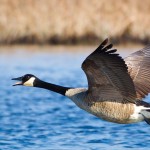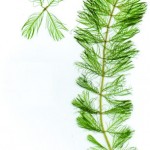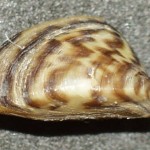state of the lake 2010
Lake Keeper Report
Final Report For 2010
by Don Mayland
Sections:
- Introduction Section 1
- Lake DataSection 2
- Weed Inventory Section 3
- Aquatic Life Section 4
- Bird Inventory Section 5
- Goals for 2011 and Beyond Section 6
Section 1: Introduction
The 2010 sampling season was dramatically different, in terms of weather, from the 2009 season. May 2010 was one of the warmest months of May on record and that pattern of unusually high daytime temperatures continued until well into the fall. While the 2009 season was very cool and rainy, the entire 2010 season was exceptionally warm and dry.
As one might expect, the surface water temperatures and the temperatures in the epiliminial layer (top 25 feet) reflected this warm weather. On June 2nd the water temperature at a depth of 10 feet was 22.1 C (roughly 73 degrees F). This level of warmth was three weeks ahead of readings in 2009. The unusually warm weather also meant that the thermocline set up earlier. Once the lake stratifies, the mixing of more highly oxygenated surface water with the deeper waters does not occur.
The very dry summer of 2010 was reflected in the water visibility readings we recorded. In 2009 the highest visibility we recorded was 4.25 meters early in the summer. That summer the visibility decreased as the water warmed up and the “whiting” effect occurred (see 2009 report in appendix to this report). This year we had readings around 4 meters until September and then the visibility increased to a high of 6.5 meters. The visibility in 2010 was the best I have recorded in the past 30 years.
This year we also did some additional chemical sampling. In particular we collected data on nitrate levels (NO3) and chloride levels (Cl-). Nitrogen enters a lake from surface runoff and seepage from groundwater. All inorganic nitrogen (nitrate included) can be used by aquatic plants and algae. If Nitrate levels exceed .3 mg/l in the spring then this is sufficient to support algae blooms. We received several nitrate readings during the summer of 2010 that exceeded .3 mg/l. Large plants, such as Eurasian Milfoil, also need nitrogen. Spring runoff from the land and septic tank leeching often provides this nitrogen. Septic tanks can also provide chloride (Cl-). Other chloride sources can be animal waste, potash fertilizer and drainage from road salting. Chloride is non toxic to aquatic organisms and it does not affect plant and algae growth. It is, however, a good indicator of pollutants entering the lake. Chloride readings of 50 to 100 mg/l are common in septic tank effluent. With one exception, which was a reading of questionable accuracy, all chloride readings we obtained were in the 23 to 24 mg/l range. Lakes vary in their natural chloride content so it is important to establish a data base over an extended period of time to establish a particular lake’s base line chloride readings. Heavy rain or snow melt can cause septic effluent and road drainage to enter the lake. Readings on these occasions need to be compared with the baseline readings obtained during more normal conditions.
Section 2 of this report is a compilation of the data collected during the 2010 field season. Unless otherwise indicated chemical readings are expressed in mg/l, temperatures are expressed in degrees Celsius and visibility is expressed in meters.
Invasive weed growth continues to be a source of concern. Section 3 of this report contains a map of the location of the established Eurasian Milfoil weed beds during the 2010 open water season. In addition we mapped the areas where competitors to milfoil have become well established. Typically these native weeds are Chara, common Elodea and Tape Grass. This section of the report also contains a photographic inventory of the predominant weeds in the lake. Milfoil growth was greater in 2010 than in 2009, although it is still below some of the heavy growth years. Caddis Fly Larvae were evident but not the very large population that was observed in 2009.
Section 4 is a discussion of aquatic life observed, as in the case of grass carp, or not seen, as in the case of zebra mussels, during the 2010 season. Gloeotrichia was abundant again this year although it had little impact on the extremely good visibility we experienced from the time the lake first stratified until the fall turnover in early November. The 2009 report contains more information about this potentially nuisance algae.
The diversity of bird life around the lake is impressive and a source of great pleasure to observers of wildlife. However, the large population of Canada Geese, especially in the late falls, is also a source of real pain for the lake. Canada Geese guano is a major source of phosphate and nitrate loading in the bottom silt.
Section 5 of this report is a discussion of this bird life.
The report ends with Section 6, which is a discussion of the 2011 goals of the Lake Keeper Program.
The Cary Institute (Institute of Ecosystems Studies) again processed the water samples for total phosphorus. Chris Oostenink came out sampling as often as I did and he provided the interpretation that the data requires.
The Hotchkiss School, in addition to helping fund the Lake Keeper program, provided the use of their 20’Boston Whaler and many of the instruments needed to obtain the data presented in this report.
The Lake Keeper program is funded, in equal parts, by the Lake Wononscopomuc Association, The Hotchkiss School and the Town of Salisbury.
Section 2
Lake Data
Buoy A
| Date | Temperature | Depth |
|---|---|---|
| 4/2/10 | 5.9°C | 10′ |
| 4/2/10 | 5.7°C | 30′ |
| 4/2/10 | 5.7°C | 50′ |
| 4/16/10 | 11.2°C | 10′ |
| 4/16/10 | 6.2°C | 30′ |
| 4/16/10 | 5.8°C | 50′ |
| 4/29/10 | 11.2°C | 10′ |
| 4/29/10 | 6.5°C | 30′ |
| 4/29/10 | 6.0°C | 50′ |
| 5/21/10 | 17.0°C | 10′ |
| 5/21/10 | 8.8°C | 30′ |
| 5/21/10 | 6.1°C | 50′ |
| 6/2/10 | 22.1°C | 10′ |
| 6/2/10 | 8.7°C | 30′ |
| 6/2/10 | 6.3°C | 50′ |
| 6/19/10 | 20.7°C | 10′ |
| 6/19/10 | 9.6°C | 30′ |
| 6/19/10 | 6.2°C | 50′ |
| 6/29/10 | 25°C | 10′ |
| 6/29/10 | 10°C | 30′ |
| 6/29/10 | 6°C | 50′ |
| 7/18/10 | 27.0°C | 10′ |
| 7/18/10 | 9.1°C | 30′ |
| 7/18/10 | 6.6°C | 50′ |
| 8/3/10 | 25.6°C | 10′ |
| 8/3/10 | 15.8°C | 30′ |
| 8/3/10 | 6.7°C | 50′ |
| 8/16/10 | 25°C | 10′ |
| 8/16/10 | 10.7°C | 30′ |
| 8/16/10 | 6.6°C | 50′ |
| 9/7/10 | 22.5°C | 10′ |
| 9/7/10 | 10.7°C | 30′ |
| 9/7/10 | 6.5°C | 50′ |
| 9/21/10 | 19.8°C | 10′ |
| 9/21/10 | 12.6°C | 30′ |
| 9/21/10 | 7°C | 50′ |
| 9/29/10 | 19.9°C | 10′ |
| 9/29/10 | 12.5°C | 30′ |
| 9/29/10 | 6.7°C | 50′ |
| 10/26/10 | 13.1°C | 10′ |
| 10/26/10 | 12.7°C | 30′ |
| 10/26/10 | 6.9°C | 50′ |
| 11/15/10 | 9.3°C | 10′ |
| 11/15/10 | 9.3°C | 30′ |
| 11/15/10 | 7.3°C | 50′ |
Buoy A Monthly Averages
| Date | Temperature | Depth |
|---|---|---|
| April | 9.4°C | 10′ |
| April | 6.1°C | 30′ |
| April | 5.8°C | 50′ |
| May | 17°C | 10′ |
| May | 8.8°C | 30′ |
| May | 6.1°C | 50′ |
| June | 22.6°C | 10′ |
| June | 9.4°C | 30′ |
| June | 6.17°C | 50′ |
| July | 27°C | 10′ |
| July | 9.1°C | 30′ |
| July | 6.6°C | 50′ |
| Aug | 25.3°C | 10′ |
| Aug | 13.25°C | 30′ |
| Aug | 6.65°C | 50′ |
| Sep | 29.73°C | 10′ |
| Sep | 11.9°C | 30′ |
| Sep | 6.7°C | 50′ |
| Oct | 13.1°C | 10′ |
| Oct | 12.7°C | 30′ |
| Oct | 6.9°C | 50′ |
| Nov | 9.3°C | 10′ |
| Nov | 9.3°C | 30′ |
| Nov | 7.3°C | 50′ |
Buoy B
| Date | Temperature | Depth |
|---|---|---|
| 4/2/10 | 5.9°C | 10′ |
| 4/2/10 | 5.7°C | 30′ |
| 4/2/10 | 5.6°C | 50′ |
| 4/2/10 | 5.2°C | 95′ |
| 4/16/10 | 11.9°C | 10′ |
| 4/16/10 | 6.5°C | 30′ |
| 4/16/10 | 5.8°C | 50′ |
| 4/16/10 | 5.4°C | 95′ |
| 4/29/10 | 11.3°C | 10′ |
| 4/29/10 | 6.5°C | 30′ |
| 4/29/10 | 5.8°C | 50′ |
| 4/29/10 | 5.4°C | 95′ |
| 5/21/10 | 16.7°C | 10′ |
| 5/21/10 | 8.1°C | 30′ |
| 5/21/10 | 6.1°C | 50′ |
| 5/21/10 | 5.6°C | 95′ |
| 6/2/10 | 22.8°C | 10′ |
| 6/2/10 | 9.1°C | 30′ |
| 6/2/10 | 6.4°C | 50′ |
| 6/2/10 | 5.6°C | 95′ |
| 6/19/10 | 21.8°C | 10′ |
| 6/19/10 | 9.6°C | 30′ |
| 6/19/10 | 5.6°C | 50′ |
| 6/19/10 | 5.6°C | 95′ |
| 6/29/10 | 25.2°C | 10′ |
| 6/29/10 | 10.3°C | 30′ |
| 6/29/10 | 6.4°C | 50′ |
| 6/29/10 | 5.6°C | 95′ |
| 7/18/10 | 27.1°C | 10′ |
| 7/18/10 | 10.1°C | 30′ |
| 7/18/10 | 6.6°C | 50′ |
| 7/18/10 | 5.7°C | 95′ |
| 8/3/10 | 25.4°C | 10′ |
| 8/3/10 | 15.6°C | 30′ |
| 8/3/10 | 6.5°C | 50′ |
| 8/3/10 | 5.7°C | 95′ |
| 8/16/10 | 24.9°C | 10′ |
| 8/16/10 | 11°C | 30′ |
| 8/16/10 | 6.5°C | 50′ |
| 8/16/10 | 5.7°C | 95′ |
| 9/7/10 | 22.8°C | 10′ |
| 9/7/10 | 12°C | 30′ |
| 9/7/10 | 6.4°C | 50′ |
| 9/7/10 | 5.9°C | 95′ |
| 9/21/10 | 19.7°C | 10′ |
| 9/21/10 | 13.1°C | 30′ |
| 9/21/10 | 6.6°C | 50′ |
| 9/21/10 | 5.8°C | 95′ |
| 9/29/10 | 20°C | 10′ |
| 9/29/10 | 13.4°C | 30′ |
| 9/29/10 | 6.6°C | 50′ |
| 9/29/10 | 5.8°C | 95′ |
| 10/26/10 | 13.2°C | 10′ |
| 10/26/10 | 12.7°C | 30′ |
| 10/26/10 | 7°C | 50′ |
| 10/26/10 | 5.9°C | 95′ |
| 11/15/10 | 9.3°C | 10′ |
| 11/15/10 | 9.2°C | 30′ |
| 11/15/10 | 7.6°C | 50′ |
| 11/15/10 | 5.9°C | 95′ |
Buoy B Monthly Averages
| Date | Temperature | Depth |
|---|---|---|
| April | 9.7°C | 10′ |
| April | 6.2°C | 30′ |
| April | 5.7°C | 50′ |
| April | 5.3°C | 95′ |
| Date | Temperature | Depth |
| May | 16.7°C | 10′ |
| May | 8.1°C | 30′ |
| May | 6.1°C | 50′ |
| May | 5.6°C | 95′ |
| Date | Temperature | Depth |
| June | 22.8°C | 10′ |
| June | 9.67°C | 30′ |
| June | 6.1°C | 50′ |
| June | 5.6°C | 95′ |
| Date | Temperature | Depth |
| July | 27.1°C | 10′ |
| July | 10.1°C | 30′ |
| July | 6.6°C | 50′ |
| July | 5.7°C | 95′ |
| Date | Temperature | Depth |
| Aug | 25.15°C | 10′ |
| Aug | 13.3°C | 30′ |
| Aug | 6.46°C | 50′ |
| Aug | 5.7°C | 95′ |
| Date | Temperature | Depth |
| Sep | 20.8°C | 10′ |
| Sep | 12.87°C | 30′ |
| Sep | 6.5°C | 50′ |
| Sep | 5.83°C | 95′ |
| Date | Temperature | Depth |
| Oct | 13.2°C | 10′ |
| Oct | 12.7°C | 30′ |
| Oct | 7°C | 50′ |
| Oct | 5.9°C | 95′ |
| Date | Temperature | Depth |
| Nov | 9.3°C | 10′ |
| Nov | 9.2°C | 30′ |
| Nov | 7.6°C | 50′ |
| Nov | 5.9°C | 95′ |
Buoy C
| Date | Temperature | Depth |
|---|---|---|
| 4/2/10 | 6.1°C | 10′ |
| 4/2/10 | 5.6°C | 30′ |
| 4/2/10 | 5.5°C | 50′ |
| Date | Temperature | Depth |
| 4/16/10 | 11.9°C | 10′ |
| 4/16/10 | 6.7°C | 30′ |
| 4/16/10 | 5.8°C | 50′ |
| Date | Temperature | Depth |
| 4/29/10 | 11.3°C | 10′ |
| 4/29/10 | 6.9°C | 30′ |
| 4/29/10 | 5.8°C | 50′ |
| Date | Temperature | Depth |
| 5/21/10 | 17.2°C | 10′ |
| 5/21/10 | 9.1°C | 30′ |
| 5/21/10 | 6.5°C | 50′ |
| Date | Temperature | Depth |
| 6/2/10 | 23.2°C | 10′ |
| 6/2/10 | 9°C | 30′ |
| 6/2/10 | 6.6°C | 50′ |
| Date | Temperature | Depth |
| 6/19/10 | 21.6°C | 10′ |
| 6/19/10 | 10°C | 30′ |
| 6/19/10 | 6°C | 50′ |
| Date | Temperature | Depth |
| 6/29/10 | 25.4°C | 10′ |
| 6/29/10 | 9.9°C | 30′ |
| 6/29/10 | 6.9°C | 50′ |
| Date | Temperature | Depth |
| 7/18/10 | 27.2°C | 10′ |
| 7/18/10 | 10.1°C | 30′ |
| 7/18/10 | 6.0°C | 50′ |
| Date | Temperature | Depth |
| 8/3/10 | 25.4°C | 10′ |
| 8/3/10 | 16.0°C | 30′ |
| 8/3/10 | 6.7°C | 50′ |
| Date | Temperature | Depth |
| 8/16/10 | 24.7°C | 10′ |
| 8/16/10 | 5.6°C | 30′ |
| 8/16/10 | 7.2°C | 50′ |
| Date | Temperature | Depth |
| 9/7/10 | 22.7°C | 10′ |
| 9/7/10 | 11.3°C | 30′ |
| 9/7/10 | 7.3°C | 50′ |
| Date | Temperature | Depth |
| 9/21/10 | 19.6°C | 10′ |
| 9/21/10 | 14.0°C | 30′ |
| 9/21/10 | 7.3°C | 50′ |
| Date | Temperature | Depth |
| 9/29/10 | 20°C | 10′ |
| 9/29/10 | 12.9°C | 30′ |
| 9/29/10 | 7.7°C | 50′ |
| Date | Temperature | Depth |
| 10/26/10 | 13.6°C | 10′ |
| 10/26/10 | 12.7°C | 30′ |
| 10/26/10 | 7.8°C | 50′ |
| Date | Temperature | Depth |
| 11/15/10 | 9.4°C | 10′ |
| 11/15/10 | 9.3°C | 30′ |
| 11/15/10 | 9°C | 50′ |
Buoy C Monthly Averages
| Date | Temperature | Depth |
|---|---|---|
| April | 9.76°C | 10′ |
| April | 6.4°C | 30′ |
| April | 5.7°C | 50′ |
| Date | Temperature | Depth |
| May | 17.2°C | 10′ |
| May | 9.1°C | 30′ |
| May | 6.5°C | 50′ |
| Date | Temperature | Depth |
| June | 23.4°C | 10′ |
| June | 9.6°C | 30′ |
| June | 6.5°C | 50′ |
| Date | Temperature | Depth |
| July | 27.05°C | 10′ |
| July | 10.1°C | 30′ |
| July | 6.0°C | 50′ |
| Date | Temperature | Depth |
| Aug | 25.05°C | 10′ |
| Aug | 13.35°C | 30′ |
| Aug | 6.95°C | 50′ |
| Date | Temperature | Depth |
| Sep | 20.76°C | 10′ |
| Sep | 12.7°C | 30′ |
| Sep | 7.26°C | 50′ |
| Date | Temperature | Depth |
| Oct | 13.6°C | 10′ |
| Oct | 12.7°C | 30′ |
| Oct | 7.8°C | 50′ |
| Date | Temperature | Depth |
| Nov | 9.4°C | 10′ |
| Nov | 9.3°C | 30′ |
| Nov | 9.0°C | 50′ |
Section 3
Weed Inventory
The information presented in this section is a result of observations made during dives over the past two years. A more formal weed inventory was prepared by George Knoecklein of Northeast Aquatic Research,LLC in 2007. Aquatic Control Technology, Inc. has also conducted weed inventories using more controlled procedures.
Eurasian Milfoil continues to be the dominant aquatic weed in the lake. There is evidence, however, that “competitors” to milfoil are establishing themselves. When milfoil crashes, due to caddis fly larvae predation, Chara seems to quickly carpet the exposed bottom sediment. Curly Leaf pond weed, another invasive, also is quick to move in. In 2009 we saw a dramatic decline in the Eurasian Milfoil population. Again, this was largely due to the large caddis fly larvae population. However, 2010 saw a renewal of many of the destroyed milfoil beds. The good news is that at the end of the summer milfoil had not yet dominated all of the shoreline of the lake as it previously had done. The map in this section shows the approximate location of the established milfoil beds (outlined in red) at the end of the 2010 growing season. Outlined in green are the areas where Chara is well established. Clearly the natural predation by caddis larvae and the harvesting program are having some effect on the milfoil population.
The following table lists the weed species we observed on several dives over the last two years.
Section 4 contains additional comments about milfoil control and the identification of other potentially harmful invasive aquatic weeds.
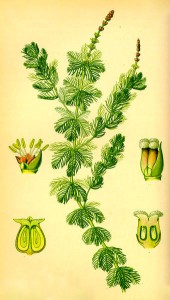

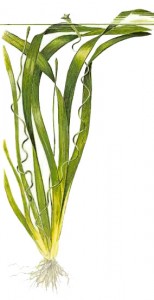

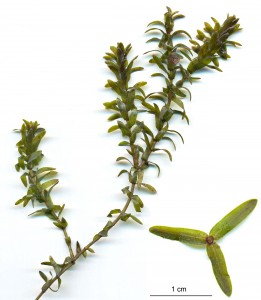
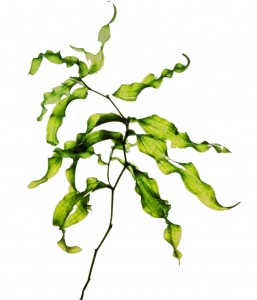
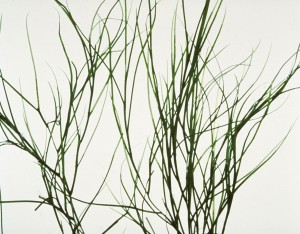
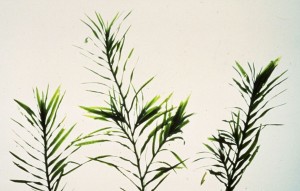
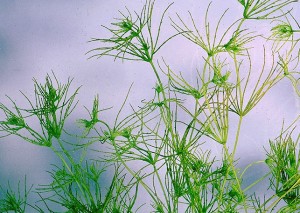
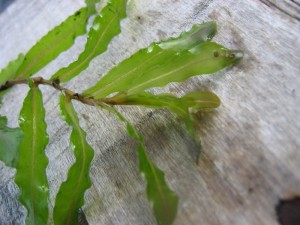
In several photos you will observe what appears to be a layer of dust. This is actually calcium precipitate, called Marl that is very pronounced in Lake Wononscopomuc.
During the past two years of sampling we have observed several beds of Phragmities that are slowly expanding. These are indicated in blue on the map below.
Section 4
Aquatic Life
Zebra Mussels, Geese and Eurasian Milfoil are the big three concerns for the lake.
Two of them we already have and need to continue to control. The third, zebra mussels, we don’t yet have and we need to keep up the efforts to prevent them from entering our lake. The lake association funds the inspection of boats that are launched at the Town Grove. This is the front line effort at preventing the larvae of zebra mussels from getting into the lake from bilge water and engine cooling water from boats that have been in waters infested with the thumbnail size mussels.
Those waters are close by. The Hudson River and Lake Champlain have had zebra mussels for several decades and the Twin Lakes supports a large population. The Housatonic River has zebra mussels north of Great Barrington and to the south in Lake Lillanona. Boats from these water bodies can logically be brought to Lake Wononscopomuc for fishing and recreation.
The only real boat ramp on the lake is at the Town Grove so inspection of boats at that point is essential. In 2010 440 boats were launched at the ramp at the Town Grove. However, canoeing and kayaking have become increasingly popular and these boats can easily be launched from any spot on the shoreline. Therefore, everyone who launches a canoe or kayak into the lake must be sure that water from another lake or river is not being transported to Lakeville Lake. In addition, all weed fragments must be removed from kayaks and canoes that are being launched. Invasive weeds can also be transported from one lake to another by boats. Ideally, boats should sit out of the water for at least five days before being launched in Lakeville Lake.
Unfortunately, Lake Wononscopomuc is an excellent potential host to zebra mussels. The geology of the lake, which is predominately Limestone, provides a large supply of calcium which is essential for mussels to develop thick shells. Once zebra mussels appear in a lake or river the pace of reproduction is high. When they are well established, the effect on the water body is always negative. Although there is some evidence that visibility improves because of the filtering actions of the mussels, this is at the expense of important plankton that feed other forms of aquatic life native to the lake. In addition, zebra mussels attach themselves to any solid object.
One of these is native mussels. This photo shows zebra mussels attached to native mussels in another body of water.

The loss of these native mussels will affect the health of the lake. Fortunately, twelve dives using SCUBA this summer and fall failed to turn up any evidence of zebra mussels.
On two dives this summer we spotted at least two grass carp. These are very large fish and not native to Lakeville Lake. There is little mistaking their identity. I originally spotted one, from the surface, hanging around the swimming lanes at the Town Grove. It is likely that someone introduced these fish as their own effort at controlling milfoil growth. This action is illegal and not at all helpful. The State DEP has been notified about our spotting these fish.
Clearly, the topic that is of most concern to all of us is the Eurasian Milfoil situation. Last year we saw a much reduced amount of milfoil, which was due to the large population of caddis fly larvae.
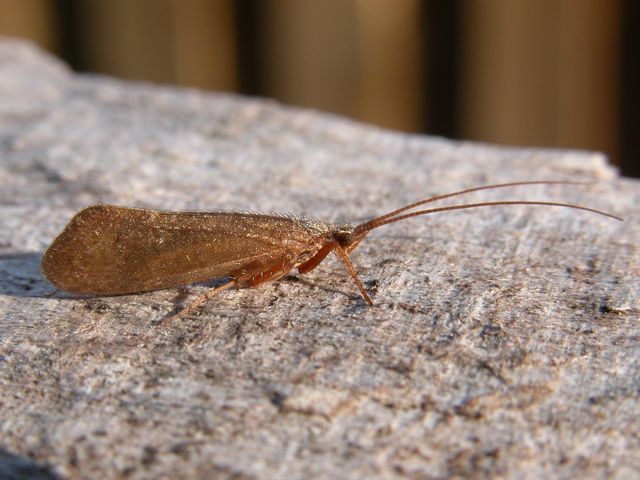
These larvae like to eat milfoil, especially the succulent branches that support the leaves. This year we found caddis larvae on the dives that we did but the population was very much smaller than the previous year. This fits the cyclical pattern that we have observed for the past 20 years.
When caddis larvae populations become very large, the milfoil gets destroyed but two to three years later the population becomes smaller and milfoil quickly recovers.
The cause of this rapid change in the population of caddis fly larvae needs a great deal more research. The State of Connecticut DEP has been notified of this observed cycle as well as researchers at The Cornell University Agricultural Extension Service. We have also observed that caddis larvae do eat other weeds.
If milfoil is not available they turn to curly leaf pond weed for instance. (See plate 18). Milfoil is definitely the food of choice for the larvae so when their population gets large enough they provide an excellent biological control of this nuisance weed.
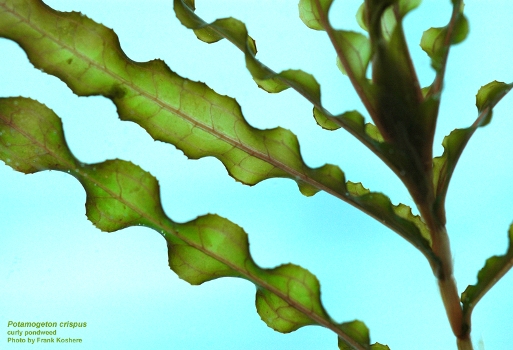
Eurasian Milfoil reproduces in three ways. They put up new shoots from their root system(runners), they flower in the late summer and early fall and they produce roots on floating plant fragments that then fall to the bottom.
It is essential that these floating fragments be collected and deposited away from the lake shore whenever possible. Fragments that wash up on the shore should be collected and removed from the area of the lake shore. Shoreline
property owners can play an important role in reducing milfoil by collecting these fragments.
It is important that everyone who uses the lake be observant of other invasive weeds that potentially could become a problem. Catching their presence early is the best way to eventually eliminate them from the lake.
Two that are of particular concern are Brazilian Elodea and Hydrilla. Click here for a short observer’s guide to help identify these weeds. Hydrilla has been identified in 6 Connecticut lakes and it is clear that it is moving west, from its eastern Massachusetts point of origin.
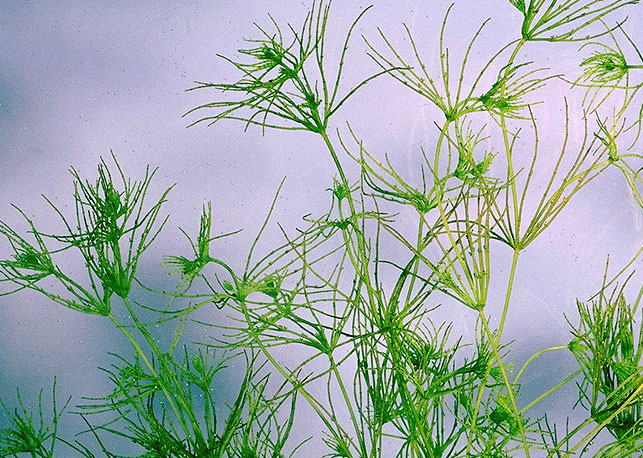
Over the past several years, and especially during the years that milfoil has been in decline, other weeds have established themselves and offer competition to the milfoil. Chara is one of these weeds. It is a low lying weed that carpets the
bottom to the extent that milfoil finds little area to set down roots.
The 2009 State of the Lake Report contains a discussion of an algae called Gloeotrichia. During much of the field season of 2010 this algae was still very evident. Despite this, the visibility was extremely good .
According to Stacey Dodge, the manager of the Town Grove, the fish caught during the 2010 season tended to be larger than she has seen in the recent past. She reports the following catches that were reported and photographed at the Grove office:
| Fish Size | Number Reported |
|---|---|
| 3 – 3.5 lbs. | 27 |
| 3.5 – 4 lbs. | 17 |
| 4 – 4.5 lbs. | 12 |
| 4.5 – 5 lbs. | 8 |
| 5+ lbs. | 16 |
Section 5
Bird Inventory
Both the weed inventory reported in Section 3 and this bird inventory are a result of observations made while we were diving or doing water sampling. They are not inventories carried out under prescribed procedures. Audubon Sharon has agreed to do a more formal bird inventory during 2011.
Last year we had anywhere from 5 to 10 Double- crested Cormorants on the lake throughout the summer and fall. This year only one showed up in the spring, found it not to his liking, and headed off, not to be seen again. This is good news, as cormorant guano can be extremely damaging to vegetation. Several islands in Lake Champlain have been completely defoliated by cormorants. We don’t need a repeat of that. We spotted no additional cormorants during the open water season.
Early in the spring there was the typical spring insect hatch which brought on a large population of Tree Swallows in search of a meal. On warm, windless afternoons and evenings these swallows could be seen skimming the surface of the lake gobbling up all of the insects that they could handle. A conservative estimate puts the number at any given time at 75 to 100.
During the past several summers and fall at least one, and frequently two, mature Bald Eagles could be seen in the trees surrounding the lake. The 2010 season was no exception.
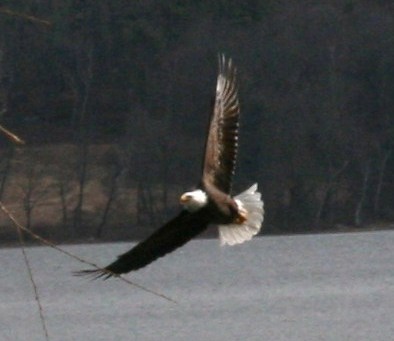
One of them stayed until ice covered the lake in late December. A single Osprey also took up summer residence in the trees surrounding the lake. I often saw him grabbing a fish that was near the surface or, on occasion, actually diving beneath the surface to stab his prey.
During the spring of the previous two years a pair of Common Loons spent about two weeks on the lake, resting on their trip north. This year they did not show, however.
A few years ago I counted 5 Swans on the lake in the early Fall. But, none appeared this year.
At least one, sometimes two, Great Blue Herons were on the lake as soon as ice went out in late March and they stayed until well into November before they headed for the shore.
The Herring Gull population has been growing every year for the past ten years. There were days during this summer when their numbers exceeded 100.
American Coots came in second in the contest for the largest population. In the fall there were large flocks that rivaled the Canada Geese. These birds are easily recognized by their short stubby bodies and white beaks. Watching them take flight is rather painful as they work hard at running across the water with wings beating rapidly in order to get up to flight speed.
Of course, no inventory of the Lake’s bird population could overlook the Canada Geese. Geese were long ago recognized as a major source of phosphorus and nitrogen inputs in the water column and bottom sediment. The Town has made efforts to control the population by issuing shooting permits and, at one time, hiring an individual to daily shoot blanks in an effort to frighten the birds away. This year, however, the Canada Geese were seen in very large numbers (exceeding 200) especially during the late fall. Lakeville Lake is always one of the last lakes to freeze and this is probably due to a combination of its depth and wind patterns on the water surface. Therefore, the large numbers of geese who feed in the corn fields across the border in New York State head to Lakeville Lake to spend the night or rest during the day. Dealing with the large population of Canada Geese has been a long standing challenge. Certainly nothing should be done to encourage the current population to stay on the lake or to attract even more. Feeding the geese is one of those encouragements.
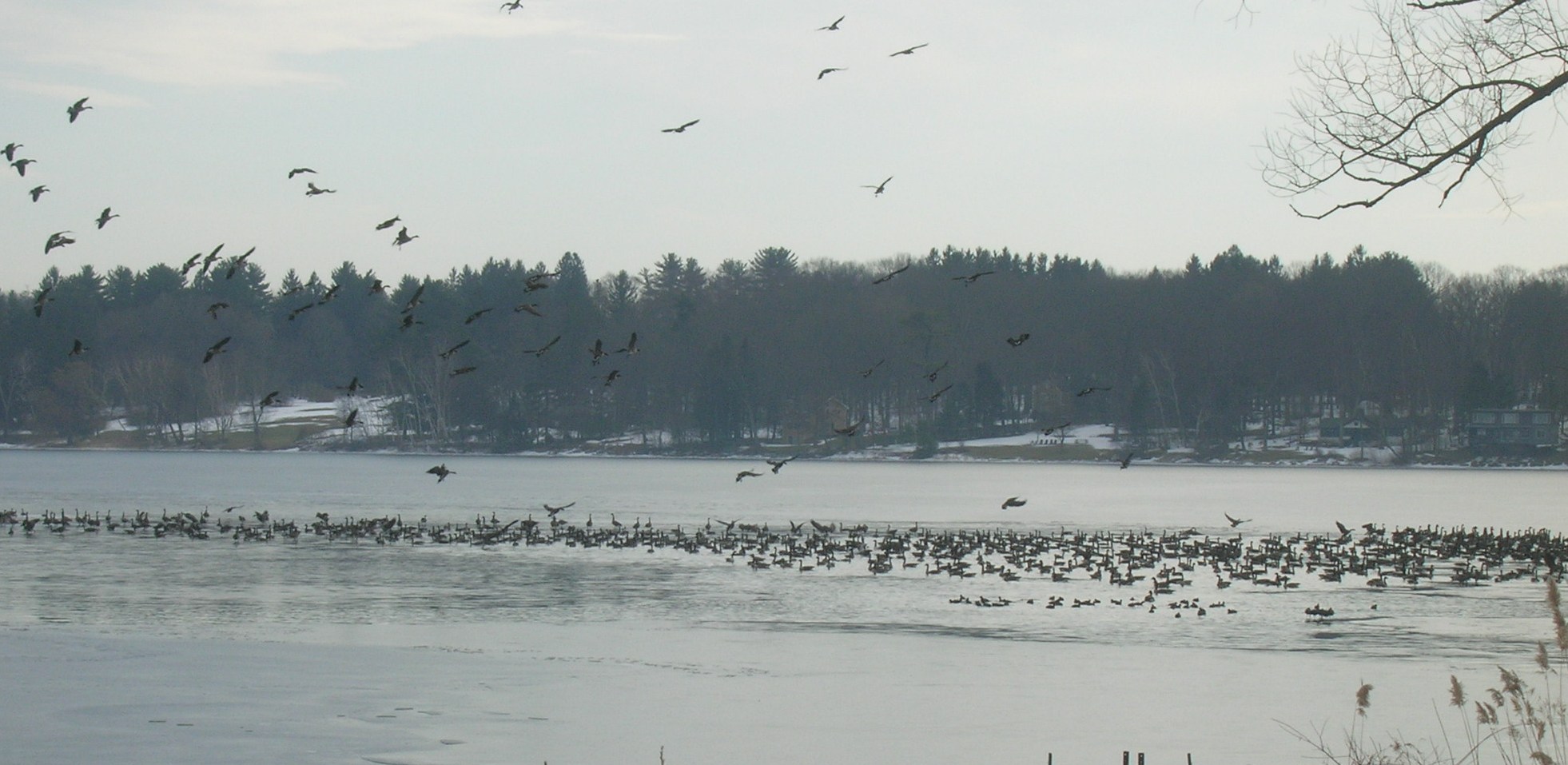
Another common bird spotted in the trees around the lake and grabbing an occasional fish was the Belted Kingfisher. These are solitary birds so getting a good count of their numbers is difficult, however, every day I was on the lake I watched at least one, but the population clearly is larger than that.
Hawks are always seen in the sky over the lake as they ride the thermals created by the water and hills around the lake.
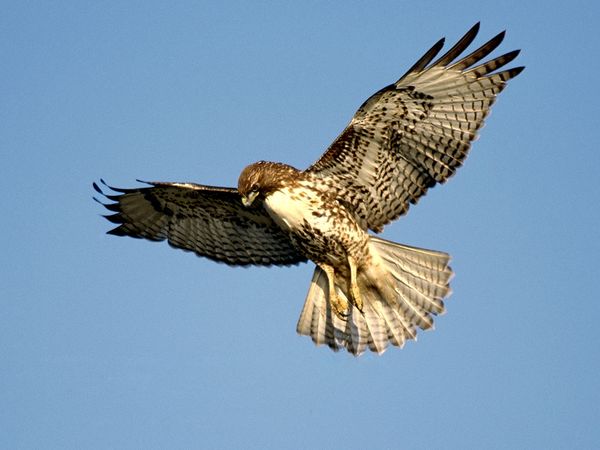
Most often we observed 2 or three Red Tail Hawks, but on one occasion I did see a Coopers Hawk flying up the gorge of sucker brook.
Along with the hawks another familiar bird we frequently saw circling the lake were Turkey Vultures. They are also good at soaring and riding the thermals.
Mallard Ducks have been long time residents of the lake in the spring, summer and fall. Typically we would see about a dozen, usually cruising close to the shore line. In addition, the past several years a large population of Common Mergansers and Hooded Mergansers has discovered the lake. We saw flocks of 20 to 30 in the fall.
Notes about 2010 Field Season
Water temperatures in 2009 were warmer in April time frame but 2010 temps in June climbed higher than 2009, above the thermocline.
Visibility in 2009 was much poorer than in 2010, through the end of June. This has continued throughout the season of 2010. Visibilities have been unusually high during the 2010 season. Probably due to the lack of runoff because it has been very dry.
Dissolved Oxygen readings are about the same between the two years. The bottom basins, in both years, become anoxic by the end of May or early June. In October the O2 levels have been lower in the deep water (50>) than in 2009.
P readings very similar between the two years. However, note the high P reading at the bottom of Buoy B
The fall of 2010 is one of the very driest in recent memory. Also, the temperatures have been well above normal.
Sep 30/Oct 1
very, very heavy rains. Visibility, prior to the heavy rain at the end of April, has been exceptionally high. There is a large population of gloeotrichia but there has been no whiting or other algae blooms.
The thermocline is around 23 feet at this date.
At the end of September the thermocline had dropped to 28’
Late Oct:
Visibility still way above normal. Very little bird life on the lake. Gloeotrichia has disappeared.
More normal rainfall, but air temperatures are in the high 60s and 70s during the day. No below freezing temperatures yet.
Dec 8:
Temps. Over the last ten days have been below normal. 30s during the day and low 20s and teens at night. No ice yet on the lake. The goose population is very high….probably due to the freezing of some of the area ponds and the snow cover on fields. Sampling season ended with the Nov 15 data collection. Fall turnover occurred in earl y November. Visibility dropped markedly at that time. It appears that there is a milkiness to the water above 20 feet. Reminds me of when we had a population of Ocillatoria in the lake.
Dec 30:
Ice In
Section 6
Goals for 2011 and Beyond
A frequent level of water quality sampling is a goal of the Lake Keeper Program. Catching problems early provides the best possibility for preventing long term damage to the health of the lake. However, budget limitations are likely to dictate that the weekly sampling we have been doing for the past two years will not continue beyond 2011. After next year we will have a good data base covering the major chemical indicators of the trophic state of the lake. We do expect to continue to compare data collected in the future with this baseline but, the frequency of collection is likely to be less than what we are currently involved in.
In 2011 we will expand the chemical analysis to collecting Chlorophyll a data. In addition, we anticipate doing an inventory of fresh water mussels and crayfish. These have been requested by the State of Connecticut DEP.
At this writing we have identified 11 drainage streams that flow into Lake Wononscopomuc. Two are year round and the others only flow after heavy rains. Mapping and chemical sampling of these streams will be done during the 2011 season.
We will continue to monitor the weed growth in the lake, keeping a close watch for new invasive plants.
Audubon Sharon will be approached about doing a formal bird inventory. Gloeotrichia and other algae need to be closely monitored. We anticipate doing a more complete inventory of algae in the lake at a variety of depths, times of the day and seasons of the year.
Donald K. Mayland
Marine Study Program, Inc.
Lakeville, CT 06039
![Lake Wononscopomuc Association [logo]](http://lakewononscopomuc.com/charon/wp-content/themes/lake-association/img/Logo100.png)
